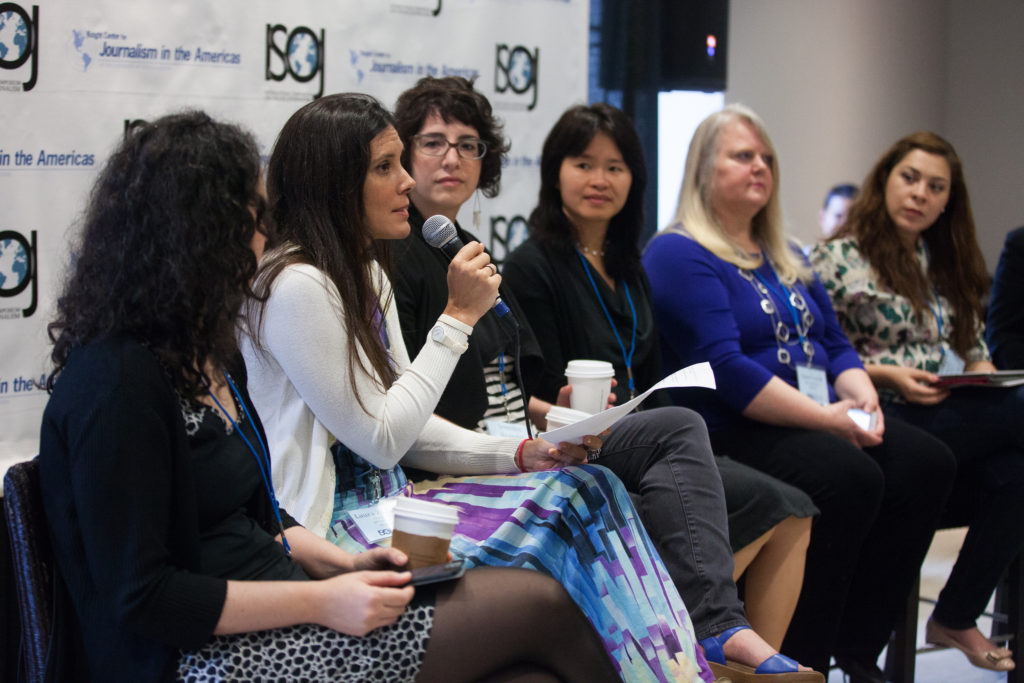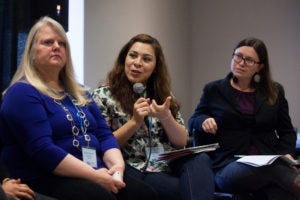April 19, 2015 | Digital Native Media
Digital journalism offers challenges and opportunities for women leaders and entrepreneurs
In a traditionally male-dominated world, women are breaking barriers in entrepreneurship. This was the focus of a panel at the 16th International Symposium on Online Journalism (ISOJ) where six women, leaders from around the world in online journalism, discussed how they are revolutionizing the news media as well as the challenges they face along the way.

Due to the growing demand of accurate and trustworthy news reporting, websites dedicated to fact checking have emerged. Laura Zommer, executive director of Chequeado in Argentina, told a breakfast gathering at ISOJ in Austin on Saturday, April 18, that her organization aims to make citizens more interested and involved in fact checking and the collection of data.
“We want fact checking to grow in Latin America,” she said. “Nine initiatives in different media in the region are doing fact checking with our help or with our method.”
Laura Lorek is the founder and director of Silicon Hills News, a start-up technology news site that covers the Austin and San Antonio regions. Lorek’s organization was launched with the help of a $12,000 grant from the McCormick New Media Women Entrepreneursinitiative in 2011, which aims to foster the entrepreneurial abilities of women in the media.
Having practiced traditional journalism for many years, one of the challenges Lorek faces is the digitalization of the news business.
“It’s been interesting to break down old barriers to new ways of doing business,” she said. “You have to think creatively, you have to try new things and they don’t always work out.”
Adapting to change and finding the resources to do so quickly has been an issue for these women entrepreneurs. Not only do they have to build from the ground up, but they also have to make the right connections to facilitate the process.
Phuong Ly, executive director at the Institute for Justice and Journalism, said one of the many disadvantages women have in entrepreneurship arises from the short amount of time they have been at the forefront.
“I think most women don’t have the connections that men do,” Ly said. “Since men have been around longer, you have to reach out to mentors.”
These obstacles discourage some women from seeking leadership positions. Francisca Skoknic, deputy director of CIPER in Chile, said that in her country, 60 to 70 percent of college students are women, yet the numbers are still low among women leaders.
“There are no women as managing editors in Chilean newspapers,” she said. “There’s a problem.”

The situation might be different in the United States, however. Jennifer Brandel, founder and CEO of Curious Nation, says there has been well-documented reports that claim mainstream media is losing women in leadership positions due to the fact that there are opportunities for them to start their own companies.
“You’re seeing women start companies at a phenomenal rate in the United States,” she said. “If you can’t find your niche in the mainstream media market anymore, you can create one in alternative jobs now.”
While some of the panelists claimed that they feel gender has been a major challenge in their careers, others placed more weight on other factors.
Dulce Ramos, executive editor at Animal Politico in Mexico, says the real challenge is in the work itself.
“I really don’t think I face challenges because of gender,” says Ramos. “My main problem is finding the correct people to work in a digital atmosphere and finding reporters who think and challenge themselves in the new ways of telling stories.”
When reflecting about how gender has played a role in her career, Ramos recalled the words of her boss, “Remember, I didn’t hire you because you’re a woman. I hired you because you’re a good worker.”
Despite the challenges, trends are changing. According to Lorek, startup teams that have a woman in a leadership position are outperforming the ones that don’t.
“Venture capitalists are looking for women leaders because they’re giving results,” she said. “My advice is that you have to make a lot of noise. You have to make people pay attention to you.”
Ly said that collaboration is key for women looking to break into the digital news space as leaders.
“I know what my weaknesses are, I know what my strengths are and to fill in my weaknesses, I partner with other people.”
Even though Ly says that although her gender has been a challenge in her professional development and the opportunities that have come her way, she ultimately believes success comes with hard work.
“People are gonna look at you as a woman first and you have to accept that and say, ‘I’m gonna work much harder and prove them wrong.’”
A video of the ISOJ panel can be accessed here.
The 16th annual ISOJ was held April 17-18 at the Blanton Museum of Art, on the campus of the University of Texas at Austin.

